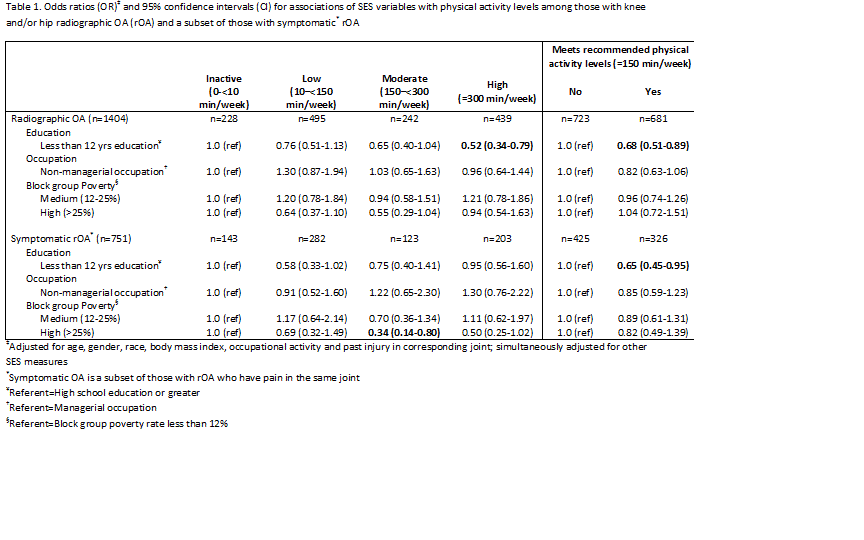Session Information
Session Type: Abstract Submissions (ARHP)
Background/Purpose: Osteoarthritis (OA) is a major cause of disability and pain in adults over the age of 45. It has been shown that physical activity (PA) can ease pain and improve quality of life for individuals with hip and knee OA, and may lessen disability. Despite these important health benefits of PA, many with OA do not exercise. Although socioeconomic factors (SES) have been associated in lower PA levels in population-based studies, they have not been meaningfully evaluated among individuals with lower body large joint OA.
Methods: We used cross-sectional data from the first follow-up and cohort replenishment of the Johnston County Osteoarthritis Project (1999-2004) which included 1,404 adults aged 45 and older with radiographic OA (rOA) of the knee and/or hip. rOA in a joint was defined as a Kellgren-Lawrence grade of ≥2. Symptomatic (sxOA) is a subset of those with rOA and symptoms in the same joint. The Minnesota Leisure Time Physical Activity questionnaire was used to collect PA information in the past year. Leisure time PA (LTPA) was assessed as a 4-level variable according to 2008 Physical Activity Guidelines for Americans based on min/wk of PA (0-9, 10-<150, ≥150-<300, ≥300 min/wk), and a dichotomous variable based on meeting Health and Human Services guidelines of ≥150 min/wk of moderate-vigorous PA. Individual SES measures were years of education (EDUC; <12 years, ³12 years) and occupation type (managerial, non-managerial); community SES was measured using Census block group poverty rate (<12%, 12-<25%, ≥25%). All logistic regression models concurrently examined SES measures for associations with PA levels among those with rOA and sxOA separately, adjusting for age, gender, race, body mass index, occupational PA, and history of injury to matching joint, using the lowest LTPA category as the referent.
Results: Participants meeting recommended PA levels tended to be younger, male, white race, not obese, not have sxOA, with EDUC ≥12 yrs and in a managerial occupation. Among those with rOA, compared to those with EDUC ≥12 yrs, those with EDUC <12 yrs were less likely to participate in high LTPA levels (≥300 min/wk; adjusted odds ratio [aOR]=0.52; 95% confidence interval [CI]=0.34-0.79) and less likely to meet recommended LTPA levels (aOR=0.68; 95% CI=0.51-0.89). Similarly, among the subset of individuals with sxOA, those with EDUC <12 yrs were less likely to meet recommended LTPA levels (aOR=0.65; 95% CI=0.45-0.95). Further, individuals with sxOA living in high poverty block groups were less likely to engage in moderate (aOR=0.34; 95% CI=0.14-0.80), or high levels of LTPA (aOR=0.50; 95% CI=0.25-1.02). Occupation type was not associated with LTPA levels.
Conclusion: In both rOA and sxOA, those with lower SES were less likely to be active or to meet HHS recommendations for PA. Since individuals with lower SES are also more likely to have OA, targeting these groups about the benefits of PA is imperative.
Disclosure:
R. J. Cleveland,
None;
K. E. Barbour,
None;
J. B. Renner,
None;
J. M. Jordan,
Trinity Partners, Inc. ,
5,
Osteoarthritis Research Society International,
6,
Chronic Osteoarthritis Management Initiative of US Bone and Joint Initiative,
6,
Samumed,
5,
Interleukin Genetics, Inc. ,
5,
Algynomics, Inc. ,
1;
L. F. Callahan,
None.
« Back to 2013 ACR/ARHP Annual Meeting
ACR Meeting Abstracts - https://acrabstracts.org/abstract/individuals-with-knee-or-hip-oa-and-low-ses-are-likely-to-be-physically-active/

